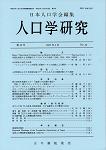Volume 38
Displaying 1-31 of 31 articles from this issue
- |<
- <
- 1
- >
- >|
Index
-
Article type: Cover
2006Volume 38 Pages Cover1-
Published: May 31, 2006
Released on J-STAGE: September 12, 2017
Download PDF (178K) -
Article type: Index
2006Volume 38 Pages Toc1-
Published: May 31, 2006
Released on J-STAGE: September 12, 2017
Download PDF (178K) -
Article type: Appendix
2006Volume 38 Pages App1-
Published: May 31, 2006
Released on J-STAGE: September 12, 2017
Download PDF (165K)
Article
-
Article type: Article
2006Volume 38 Pages 1-20
Published: May 31, 2006
Released on J-STAGE: September 12, 2017
Download PDF (438K) -
Article type: Article
2006Volume 38 Pages 21-41
Published: May 31, 2006
Released on J-STAGE: September 12, 2017
Download PDF (719K) -
Article type: Article
2006Volume 38 Pages 43-55
Published: May 31, 2006
Released on J-STAGE: September 12, 2017
Download PDF (369K) -
Article type: Article
2006Volume 38 Pages 57-72
Published: May 31, 2006
Released on J-STAGE: September 12, 2017
Download PDF (338K)
Note
-
Article type: Article
2006Volume 38 Pages 89-98
Published: May 31, 2006
Released on J-STAGE: September 12, 2017
Download PDF (400K) -
Article type: Article
2006Volume 38 Pages 99-110
Published: May 31, 2006
Released on J-STAGE: September 12, 2017
Download PDF (377K)
Scientific Information
-
Article type: Article
2006Volume 38 Pages 111-112
Published: May 31, 2006
Released on J-STAGE: September 12, 2017
Download PDF (191K) -
Article type: Article
2006Volume 38 Pages 113-114
Published: May 31, 2006
Released on J-STAGE: September 12, 2017
Download PDF (193K)
Book Reviews
-
Article type: Article
2006Volume 38 Pages 115-117
Published: May 31, 2006
Released on J-STAGE: September 12, 2017
Download PDF (238K) -
Article type: Article
2006Volume 38 Pages 118-121
Published: May 31, 2006
Released on J-STAGE: September 12, 2017
Download PDF (278K) -
Article type: Article
2006Volume 38 Pages 122-125
Published: May 31, 2006
Released on J-STAGE: September 12, 2017
Download PDF (246K) -
Article type: Article
2006Volume 38 Pages 126-127
Published: May 31, 2006
Released on J-STAGE: September 12, 2017
Download PDF (338K) -
Article type: Article
2006Volume 38 Pages 127-128
Published: May 31, 2006
Released on J-STAGE: September 12, 2017
Download PDF (338K) -
Article type: Article
2006Volume 38 Pages 128-129
Published: May 31, 2006
Released on J-STAGE: September 12, 2017
Download PDF (338K) -
Article type: Article
2006Volume 38 Pages 129-130
Published: May 31, 2006
Released on J-STAGE: September 12, 2017
Download PDF (338K) -
Article type: Article
2006Volume 38 Pages 131-
Published: May 31, 2006
Released on J-STAGE: September 12, 2017
Download PDF (336K) -
Article type: Appendix
2006Volume 38 Pages 132-133
Published: May 31, 2006
Released on J-STAGE: September 12, 2017
Download PDF (170K)
PAJ Information
-
Article type: Appendix
2006Volume 38 Pages 134-138
Published: May 31, 2006
Released on J-STAGE: September 12, 2017
Download PDF (317K) -
Article type: Appendix
2006Volume 38 Pages 139-140
Published: May 31, 2006
Released on J-STAGE: September 12, 2017
Download PDF (53K) -
Article type: Bibliography
2006Volume 38 Pages 141-148
Published: May 31, 2006
Released on J-STAGE: September 12, 2017
Download PDF (394K) -
Article type: Appendix
2006Volume 38 Pages 149-150
Published: May 31, 2006
Released on J-STAGE: September 12, 2017
Download PDF (193K) -
Article type: Appendix
2006Volume 38 Pages 151-
Published: May 31, 2006
Released on J-STAGE: September 12, 2017
Download PDF (81K) -
Article type: Appendix
2006Volume 38 Pages 152-153
Published: May 31, 2006
Released on J-STAGE: September 12, 2017
Download PDF (135K) -
Article type: Appendix
2006Volume 38 Pages 154-
Published: May 31, 2006
Released on J-STAGE: September 12, 2017
Download PDF (63K) -
Article type: Appendix
2006Volume 38 Pages 154-
Published: May 31, 2006
Released on J-STAGE: September 12, 2017
Download PDF (63K) -
Article type: Appendix
2006Volume 38 Pages App2-
Published: May 31, 2006
Released on J-STAGE: September 12, 2017
Download PDF (165K) -
Article type: Cover
2006Volume 38 Pages Cover2-
Published: May 31, 2006
Released on J-STAGE: September 12, 2017
Download PDF (126K) -
Article type: Index
2006Volume 38 Pages Toc2-
Published: May 31, 2006
Released on J-STAGE: September 12, 2017
Download PDF (126K)
- |<
- <
- 1
- >
- >|
